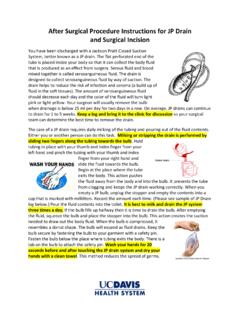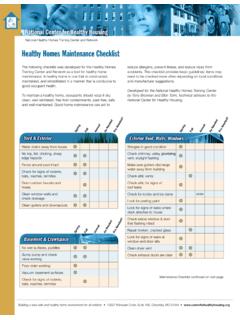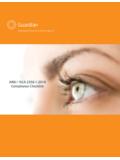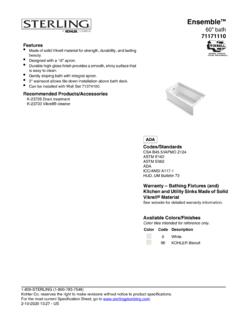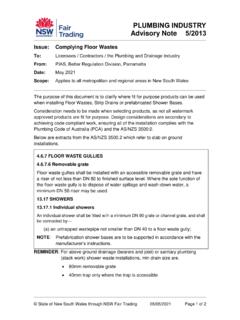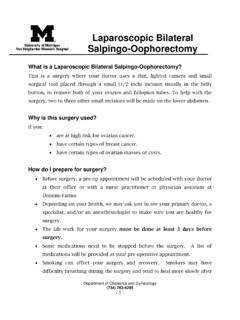Transcription of Emergency Eye Wash and Safety Shower Inspection
1 Office of Environmental Health and Safety 100 Morrissey Blvd. Boston, MA 02125-3393 _____ Emergency Eyewash and Safety Shower Inspection and Testing Standard Operating Procedure SOP Number: L -01-18 Effective Date: September 2019 1. PURPOSE The purpose of this procedure is to outline the requirements for the annual Inspection of Emergency eyewash units and Safety showers. 2. SCOPE This procedure applies to all Emergency eyewash and Shower units at UMass Boston. 3. PRECAUTIONS AND HAZARDS PRECAUTIONS: Care should be taken to ensure that water from units are contained and any spillage is cleaned up. In cases where there are not ball-valves, Facilities staff should accompany OEHS in case there are issues with the unit that need immediate attention.
2 HAZARDS: Normal testing of eyewash and Safety showers poses no unusual hazards. The primary hazards are physical related to collecting and disposing of the water flushed from the Shower units. 4. PROCEDURE 2 | P a g e Notify lab PI s/lab supervisors of inspections dates at least two (2) days in advance. Before activating Emergency eyewash and Safety Shower units for Inspection services: 1. Visually inspect the units for any irregularities and make note of them. 2. Verify that there are no obstructions around the unit. 3. Check signage. All information noted on tag must be clear and legible. Emergency Eyewash (EW): Inspect Emergency eyewash stations annually or more frequently.
3 1. Place a bowl beneath the drain of the EW station if necessary. 2. Activate the EW either by using push-lever or pulling EW away from the unit. 3. Ensure controlled flow of flushing fluid at a velocity low enough to be non-injurious to the user. 4. Record the temperature of the water (should be between 60-90 degrees F) 5. Record date and check off OK If Inspection criteria are met, if not check NG and record initials in BY column. 6. Record results on OEHS Inspection log 7. Immediately report any deficiency to OEHS office through email Include pictures of the tag and provide reason why unit is NG in the email. 8. If NG is checked off on eyewash or drench hose unit tag OUT OF ORDER yellow tag should be attached to the handle.
4 I. Fill remarks section on the tag why unit is out of service for use. ii. Sign and date the tag 3 | P a g e iii. OEHS will notify Facilities to generate work order to resolve the deficiency. OEHS will copy PI. 9. Clean up any spillage on the floor. 10. Document the results of the Inspection in OEHS log daily on shared drive. 11. Dispose of any water collected in an appropriate sink or drain. Note: Lab personnel should flush eyewash fixtures on a weekly basis as instructed in the Lab Safety Manual. Safety Shower (SS): 1. Inspect Safety Shower annually or more frequently. 2. Identify the closest sink to the Shower and clear the access for disposal of water from Shower Inspection collection bucket before testing the Shower .
5 3. Top opening of the Shower test sleeve is placed around Shower head. 4. Place the bottom opening of the Shower test sleeve into the collection bucket. 5. Activate the Shower by pulling the handle down firmly. 6. Ensure controlled flow of flushing fluid at a velocity low enough to be non-injurious to the user. 7. Only allow water to reach the 2/3 mark inside collection barrel before emptying and repeating if necessary. When possible, use extension hose and extension cord so full barrel does not need to be moved. 8. Allow water to run through the Shower until water runs clear*, and then deactivate the Shower . If inspector can t confirm water is clear, they can put Shower water in a 4 | P a g e white container to provide contrast or fill a clear jar with Shower water and compare the color with water from drinking water fountain or distilled water.
6 9. Record the temperature of the water (should be between 60-90 degrees F) 10. Record date and check off OK If Inspection criteria are met, if not check off NG and record initials in BY column. If NG is checked off, inspector needs to fill out repair tag *NOTE: If water is slightly discolored DO NOT tag the unit OUT OF SERVICE . Note in Inspection log 11. Immediately report deficiency to OEHS office through email Include pictures of the tag and provide reason why unit is NG in the email. 12. If NG is checked off on Shower unit tag for mechanical issues like a broken handle, OUT OF ORDER yellow tag should be attached to the handle.
7 I. Fill remarks section on the tag as to why unit is out of service for use. ii. Sign and date the tag 5 | P a g e iii. OEHS will notify Facilities to generate work order to resolve the deficiency. OEHS will copy PI. iv. OEHS Inspector will be provided work order number issued by Facilities in 24-48hours, which should be recorded in the Inspection log maintained on the shared online drive. v. OEHS inspector needs to keep track of open work orders issued and do weekly follow up until deficiency is corrected. vi. Remove caution tag and update Inspection tag once Inspection meets OEHS criteria. 13. Clean up any spillage on the floor. 14. Document the results of the Inspection in OEHS log daily on shared drive.
8 15. Dispose of water collected in an appropriate laboratory sink. 5. ROLES AND RESPONSIBILITES The Director of the Office of Environmental Health and Safety is responsible for approving and ensuring compliance with this procedure. Office of Environmental Health and Safety : 1. Ensure each PI or Lab Supervisor is aware of their responsibilities under this SOP; 2. Review the SOP periodically and update as necessary; 6 | P a g e 3. Test all Emergency showers and eyewash units at a minimum annually and submit work orders if deficiencies cannot be immediately corrected. Notify Facilities and tag the unit OUT OF ORDER . 4. Follow up with Facilities weekly to ensure any deficiencies are corrected in a timely manner and re-test once deficiencies are corrected.
9 5. Document all annual testing and inspections. 6. Assist with plan review and placement of new equipment during major renovation or new construction. 7. Provide guidance concerning the operation and testing of eyewash units to principal investigators (PIs) and lab supervisors as requested. Principal Investigators (PI s) and Lab Supervisors: 1. Ensure that Emergency eyewashes and showers installed in their areas are tested and inspected as specified in the Lab Safety Manual. 2. Provide instruction to visitors, students, staff and volunteers in their labs on the proper use and operation of the Emergency units/equipment in their lab to protect their health and Safety and to minimize any form of chemical, biological and radioactive exposure.
10 3. Ensure all Emergency units are provided in the workplace and are accessible; and operable. 4. Keep routes to the Emergency unit stations and the area around the equipment clear. 5. Notify OEHS if there are any issues. Laboratory Workers: 1. Know the location of the nearest Emergency units. 2. Ensure the routes to the Emergency units/equipment and the area around them are kept clear of obstructions at all times. 3. Notify the PI or lab supervisor immediately when Emergency unit is not functioning correctly, and post the tag on the unit DO NOT USE OUT OF SERVICE . 4. Understand how to operate the Emergency units/equipment. Facilities Department: 1.
